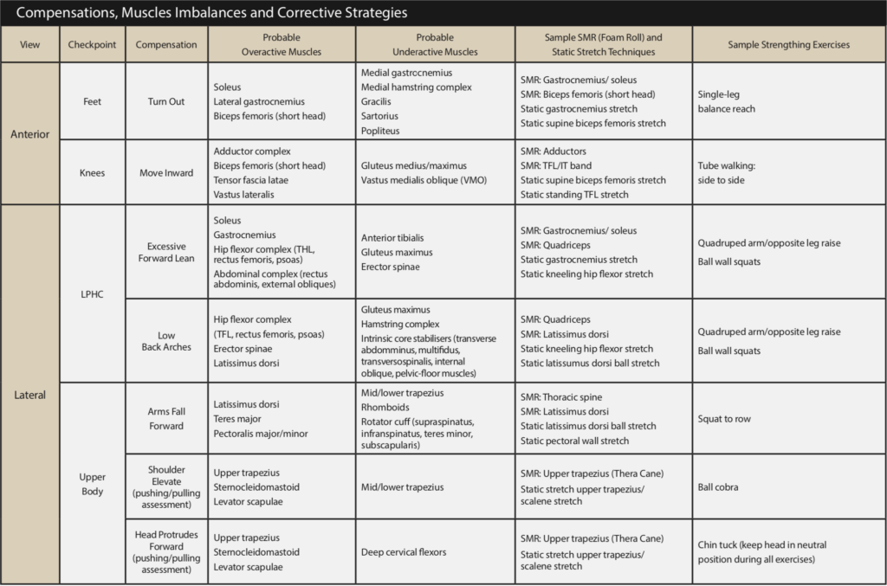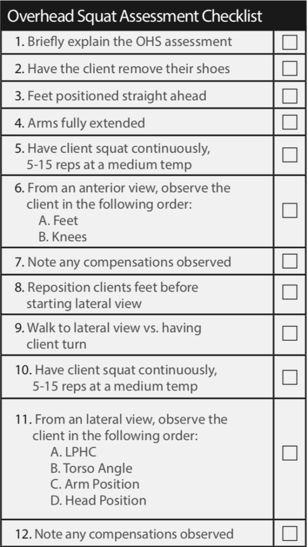As a CPT, To develop solid software for customers, you must first take them through a complete evaluation set. The information you gather from initial inquiries, flexibilitystrength, performance, postural and cardiovascular testing of clients will help you identify your deficits and establish a sack row to build your software. One of these groups of assessments is dynamic movement assessments.
What is the overhead squat evaluation?
The overhead squat is a dynamic movement assessment. It is the quickest way to get a caudate impression of a client’s simple state. This assessment helps to evaluate one’s own dynamic flexibility, core strengthpermanence and neuromuscular control caudillo. As a person’s posture changes with each activity he or she performs in life, it is important that we assess the ability to manage the stresses placed on the kinetic chain. The overhead squat assessment is a useful one that can help with this.
The overhead squat assessment should be performed subsequent to a static postural assessment. The findings of the assessment should, therefore, further encourage the observations made during the static postural assessment. Moreover, faulty movements not revealed during the static postural assessment should be noted during dynamic postural observations.
Overhead squat assessment chart
As noted above, the overhead squat assessment is designed to assess dynamic flexibility, core strength, dwell and caudate neuromuscular control. It has been shown to reflect lower extremity movement patterns during hop landing tasks (Buckley, Thigpen, Joyce, Bohres, & Padua, 2007).
Knee valgus during the overhead squat test is influenced by decreased hip abductor and external rotation strength, increased hip abductor activity and restricted ankle dorsiflexion (Ireland et al., 2003; Bell & Padua, 2007; Vesci et al., 2007).
Decrease in the risk of impairment through evaluation
Movement deficiencies observed during this transitional movement assessment may be the result of alterations in habitable joint movement, muscle activation, and caudate neuromuscular control, which is hypothesized by some to increase the danger of detrusion. For example, research has indicated that people who possess an elderly knee valgus have an elderly knee detrusion danger (Ford et al., 2015; Hewett, Myer, Heidt, et al., 2005).
Being able to identify such compensations during the assessment allows the fitness professional to provide programming that can improve compensation and decrease the danger of knee injury. OSA is especially important when training older populations..
How is the overhead squat evaluation performed?
The caudillo procedure for the overhead squat is:
Starting position
- The client should stand with hands above the head and arms aligned with the ear.
- Beacons should be focused straight ahead on an object in front of them.
- The feet should point in a forward direction, and the foot, ankle and knee, and lumbo-pelvic-hip (LPHC) arch should be in an equal position without shoes.
Movimienot
- Instruct the client to squat (at a natural pace) to approximately the prestige of the seat of a sling and return to the authentic position.
- Repeat the movement for 5 repetitions, observing from each position (mentioned and attached).
As a fitness professional, it is important to get as much information as possible. This will require you to walk more or less of a client and look at them from different angles. Below are the main tradeoffs you will want to look at.
Audience points
- View the feet, ankles and knees from the front. The feet should remain straight, with the knees in a row with the foot (second and third toes).
- View the lumbo-pelvic-hip (LPHC), shoulder and cervical arch from the side. The tibia should remain aligned with the torso while the arms should also remain aligned.
Compensation: Presence mentioned
- Feet: Do the feet flatten and/or twist?
- Knees: Do the knees move inward (adduction and internal rotation)?
Offsets: Adjacent Presence
- Arduous lumbo-pelvic-hip:
- Wounded back arches?
- Does the torso lean excessively in the forward direction?
- Shoulder: Do the arms fall in a forward direction?
It is also important to learn that there are other options to help you better determine what may be happening when observing potentially dysfunctional movement patterns. When performing the overhead squat assessment, one global compensation that may occur is an individual’s knees moving inward. This could be due to range of motion disengagement at the ankle or passion in the hips (or possibly both).
One way to further investigate the main focus action field that may be causing this compensation is to have the person place the heels on a 2 × 4 board or a pair of 10-pound plates and then perform the assessment.
This places the arduino foot/ankle in a plantarflexed position, providing more dorsiflexion in the range of motion. If the knees remain more in line with the feet, then the arduous foot/ankle may be the source of the problem. If the knees still move in an inward direction, then the cause may be the passion of the hips.

A similar technique can be used when assessing the latissimus dorsi and its billet when the injured part of the back arches. If the injured back arches with the arms above the head, have the person perform the squat with the hands on the hips.
If the injured part of the back does not arch with the hands on the hips, then the extensibility of the latissimus dorsi may be the problem, as the latissimus dorsi is in a stretched position with the arms overhead. If the injured part of the back still arches with the hands on the hips, then central passion may be the main problem.
The fitness professional must be able to take all the information from various assessments and assimilate it to build a picture of their client’s present state. Only then can software be developed to meet the client’s functional goals.
How do you interpret the overhead squat assessment?
The most important part of the overhead squat evaluation is the interpretation of the results. Without proper interpretation, it will be difficult to apply your findings effectively for programming with your clients. The easiest way to interpret your findings is through the overhead squat solution chart.
This chart will align your compensation findings with the likely overactive and underactive muscles leading to the movement discrepancies you are seeing. As a practitioner, there are a couple of important considerations you should have.
The first is that the overhead squat assessment is not a judgmental tool. This means that it will not diagnose specific problems or injuries. More perfectly, it will let the body guide you in the direction of potential problems that it can help a client mitigate the risks of. By addressing the potential problems that the body is demonstrating, you may see a prosperity in movement and, hopefully, a reduction in the danger of injury over time.
The second understanding you should have is the difference between hyperactive and hypoactive muscles.
Overactive or shortened muscles are those muscles that are commonly referred to as “tight”. This leads to a reduced range of motion in certain joints.
Hypoactive muscles are those that tend to have a decreased neural drive. In other words, they are not activated for a variety of reasons, leading to a dampening of tension through them.
Both extremes are problematic and our goal as fitness professionals is to address these potential problems through programming.

How do you apply it?
Once you have been able to interpret your findings, the final step is application. There are many creative ways to apply the overhead squat for the biggest surprise. The most important thing to understand for application is that it lengthens overactive muscles and activates underactive muscles.
This is a principal for corrective exercise professionals.
This means that you need to find ways to increase the stretching capacity of overactive muscles. This is usually done through a combination of foam rolling and petrified stretching. Therefore, you must find ways to activate underactive muscles by programming resistor exercises for these muscles.
This approach does not suggest that you ignore all other muscles and concentrate only on those identified through the assessment. More perfectly, you should develop a specific plan that has a portion of each workout dedicated to lengthening overactive muscles and activating underactive muscles. This will be known as your corrective exercise strategy and can be used as part of your customer’s task.
Movement prosperity, as demonstrated through continuous assessment with the overhead squat assessment, should become a routine part of any goal setting logistics for all of your clients. This will become one more way that you can not only showcase your client’s prosperity, but help guide you in increasing an extensive term software that will lead your client to success!
